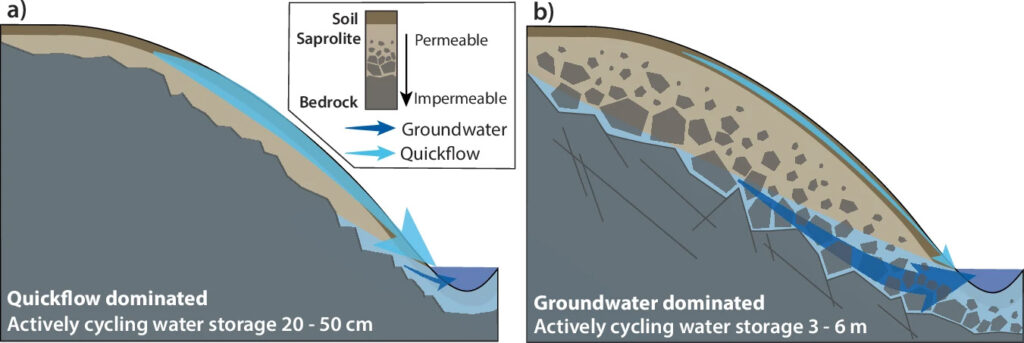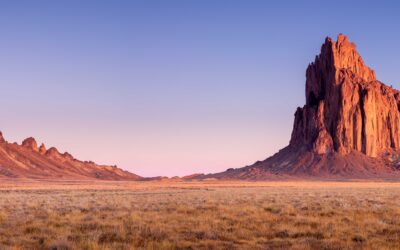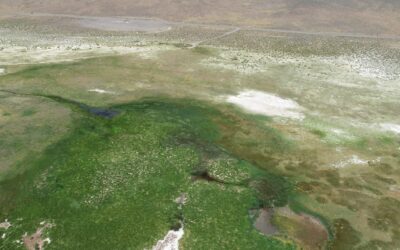New research finds water flowing out of Western ranges is, on average, more than 5 years old, demonstrating that runoff has a prolonged underground journey.
DRI’s Rosemary Carroll, Research Professor of Hydrology, co-authored a new study that found spring runoff in mountains across the Western U.S. is much older than previously known. Using advanced dating techniques, the research discovered that melting mountain snowpacks first replenish groundwater reserves before filling springs several years later. This means that the water relied on by communities across the West takes over five years from snowflake to streamflow. The research has implications for water management and our understanding of the changing dynamics of water availability.
The study is the latest in Carroll’s long career studying groundwater in mountain systems of the Western U.S., a region balancing population growth with volatile weather changes and dwindling water availability. It builds on another recent study, led by Carroll and published in February, that explored how groundwater depth dictates the way mountain streamflow responds to — and recovers from — periods of drought.
“Groundwater matters in mountain systems and should not be ignored,” Carroll said. “We need to better understand our groundwater to plan for periods of prolonged drought. We now know that deeper, older groundwater systems can support streamflow during an extensive drought, but this comes at the expense of a longer recovery. In contrast, those mountain basins dependent on shallow and younger groundwater will see dramatic reductions in streamflow with even a short drought but can recover more quickly.”
Carroll compares these contrasting water basins and their drought resilience to credit cards. One with a higher credit limit can support larger emergency spending, but will take longer to pay off, while one with a low limit can only support smaller emergencies but can be repaid more quickly.
Read the original press release from the University of Utah below:
By Brian Maffly
Growing communities and extensive agriculture throughout the Western United States rely on meltwater that spills out of snow-capped mountains every spring. The models for predicting the amount of this streamflow available each year have long assumed that a small fraction of snowmelt each year enters shallow soil, with the remainder rapidly exiting in rivers and creeks.
New research from University of Utah hydrologists, however, suggests that streamflow generation is much more complicated. Most spring runoff heading to reservoirs is actually several years old, indicating that most mountain snowfall has a years-long invisible journey as groundwater before it leaves the mountains.
The findings also indicate there is an order of magnitude more water stored underground than most Western water managers account for, said research leader Paul Brooks, a professor of geology and geophysics.
“On average, it takes over five years for a snowflake that falls in the mountains to exit as streamflow,” Brooks said. “Most of our models, whether for predicting streamflow or predicting how much water trees will have in dry years, are based on the idea that there’s very little water stored in the mountains. Now we know that that’s not the case. Most of the water goes into the ground and it sits there for somewhere between three and 15 years before it’s either used by plants or it goes into the streams.”
The team collected runoff samples at 42 sites and used tritium isotope analysis to determine the age of the water, that is how much time elapsed since it fell from the sky as snow.
Published May 3 in the journal Nature Communications Earth & Environment, the findings were co-authored by U geology professors Sara Warix and Kip Solomon in collaboration with research scientists around the West.

Determining the age of mountain streamflow is a prerequisite for predicting how mountain hydrology will respond to changes in climate and land use, the researchers said.
“We know if our streams are being supported by water that’s five to 15 years old, there’s got to be a lag between input storage and response. And so even though our models have been good in the past, good enough to make decisions about water use, the inputs to our systems are changing. There’s going to be changes throughout the subsurface that are reflected in streams,” Warix said. “If we want to make good decisions moving forward, we need to incorporate that groundwater storage component because past mechanisms, past processes are not going to be the same in 20 or 50 years.”
Brooks conducted the sampling in 2022 while on sabbatical, visiting 42 sites twice, once in the midwinter to capture the stream’s “base flow” that was presumably fed entirely by groundwater and again during the spring runoff.
“The sampling sites are locations where there was a fair amount of existing research, a geographical distribution from the front range of Colorado to the eastern slopes of the Sierra,” Brooks said. The sites were in Idaho, Wyoming, Utah, Colorado, California and New Mexico, representing five major river basins. Most have long-term research catchments funded by the U.S. Geological Survey, the National Science Foundation or the Department of Energy.
The state of Utah’s tracking is particularly robust, providing continuous streamflow data dating back 120 years. It’s an unparalleled dataset that has enabled hydrologists to document historic cycles in climate and streamflow that would otherwise have been missed, Brooks said.
According to Solomon, the vast majority of Earth’s fresh, usable water is underground, but just how much is there remains a puzzle. Dating water offers clues, and for determining the age of water, Solomon turns to tritium, a radioactive isotope of hydrogen with a half-life of 12.3 years.

Tritium is produced naturally in the upper atmosphere, is a byproduct of nuclear reactors, and was once produced during weapons testing during the Cold War. By determining how many atoms of tritium are in a water sample relative to other hydrogen atoms, scientists can calculate when water fell from the sky as precipitation—but only as far back as a century.
The average age of the runoff sampled in the study varies among the catchment basins depending on their geology. The more porous the ground, the older its water is, since the subsurface can hold a lot more water. By contrast, glaciated canyons with low permeability and shallow bedrock, such as Utah’s Little Cottonwood Canyon, provide far less subsurface storage and younger waters, according to the study.
For decades, federal and state water managers have relied on a network of snowpack monitoring sites to provide data to guide forecasts of water availability for the upcoming year. It’s now clear that such snowpack data doesn’t provide a complete picture, according to the researchers.
“For much of the West, especially the Interior West where this study is based, our models have been losing skill,” Brooks said.
The growing disconnect between snowfall, snowpack volumes and streamflow is driven by variability in these large, previously unquantified subsurface water stores. As a case in point, Brooks highlighted the 2022 water year, which saw snowpacks in many Western states that were near or just below average. Yet that year experienced record low groundwater storage, resulting in much below average spring streamflow.
__________
The study titled “Groundwater dominates snowmelt runoff and controls streamflow efficiency in the western United States,” was published May 3 in Nature Communications Earth & Environment and was supported by the National Science Foundation. The research team included several scientists from other research universities in Utah, Arizona, Colorado, Idaho and Nevada, as well as the U.S. Geological Survey and the Department of Agriculture.


